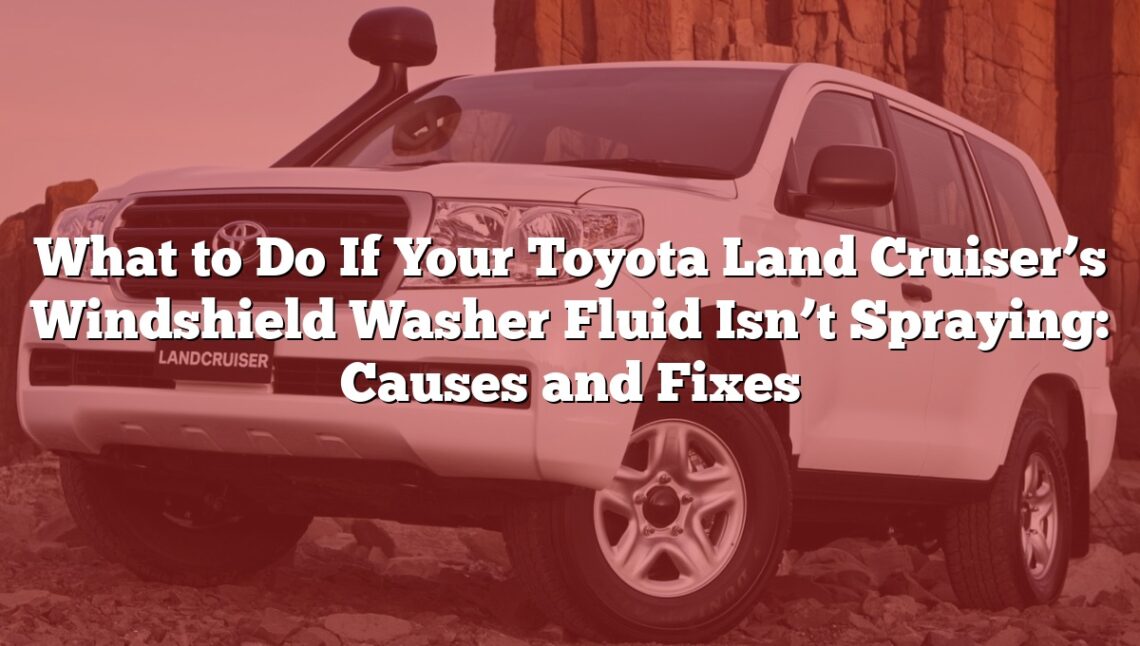Driving with a dirty windshield can be dangerous, especially when your washer fluid system fails to work. If your Toyota Land Cruiser’s windshield washer fluid isn’t spraying, it could be due to a variety of issues, from simple clogs to faulty components. This guide walks you through common causes and practical fixes to get your washer system back in top shape, ensuring a clear view and safer drives.
Comprehensive Guide to Fixing 32 Problems and Solutions for Your Toyota Land Cruiser’s Windshield Washer Fluid System
| N° | Problem | Solution |
|---|---|---|
| 1 | Low washer fluid level | Refill the washer fluid reservoir to the recommended level. |
| 2 | Empty reservoir | Fill the reservoir with the correct washer fluid. |
| 3 | Frozen washer fluid | Use washer fluid with antifreeze properties or thaw the fluid. |
| 4 | Frozen wiper fluid hoses | Thaw the hoses using a heat source (e.g., hair dryer) or wait for warmth. |
| 5 | Clogged washer nozzles | Clear the nozzles with a pin or compressed air. |
| 6 | Clogged wiper fluid nozzles | Use a pin or needle to remove debris, then test for flow. |
| 7 | Disconnected washer fluid hose | Reconnect the hose securely to the nozzle or pump. |
| 8 | Broken wiper fluid hoses | Replace the damaged hose with a new one. |
| 9 | Cracked or leaking washer fluid hose | Inspect and replace the hose or seal the cracks with adhesive. |
| 10 | Cracks in the wiper fluid reservoir | Replace the reservoir if it is leaking fluid. |
| 11 | Faulty washer pump | Replace the pump if it does not make a sound when activated. |
| 12 | Broken wiper fluid pump | Test the pump and replace it if it is non-functional. |
| 13 | Blown fuse for the washer system | Replace the blown fuse in the fuse box. |
| 14 | Blown pump fuse | Check and replace the pump fuse in the appropriate fuse box. |
| 15 | Faulty fluid level sensor | Clean the sensor or replace it if cleaning does not resolve the issue. |
| 16 | Faulty washer fluid reservoir cap or seal | Ensure the cap is sealed properly; replace if damaged. |
| 17 | Electrical wiring issues in the washer system | Inspect and repair faulty wiring; seek professional assistance if needed. |
| 18 | Malfunctioning wiper control switch | Replace the switch if it fails to activate the washer system. |
| 19 | Faulty relay in the washer system circuit | Test and replace the relay if it is not functioning properly. |
| 20 | Air trapped in the washer fluid lines | Bleed the air from the lines by operating the washer system repeatedly. |
| 21 | Blockage in the washer fluid reservoir | Remove and clean the reservoir thoroughly to remove any obstructions. |
| 22 | Dirt or debris in the washer fluid system | Flush the system and refill with clean washer fluid. |
| 23 | Misaligned washer nozzles | Adjust the nozzles to the correct angle manually or with a tool. |
| 24 | Use of improper or low-quality washer fluid | Replace with manufacturer-recommended washer fluid. |
| 25 | Washer fluid contaminated with algae or debris | Flush the system and clean the reservoir; use fresh washer fluid. |
| 26 | Overfilled washer fluid reservoir causing overflow issues | Drain excess fluid to the correct level. |
| 27 | Wear and tear of washer system components over time | Inspect and replace worn components. |
| 28 | Corroded electrical connectors in the washer system | Clean connectors and apply dielectric grease. |
| 29 | Damage from rodents or pests to hoses or wiring | Repair or replace damaged components; consider using deterrents. |
| 30 | Incorrect installation of washer components | Reinstall components correctly as per the vehicle manual. |
| 31 | Washer pump motor failure | Test the motor and replace it if it is defective. |
| 32 | Wiper fluid in the wrong reservoir | Drain the incorrect reservoir and refill the washer reservoir properly. |
Detailed Guide : Problems and Solutions for Your Toyota Land Cruiser’s Windshield Washer Fluid System
1. Low Washer Fluid Level
If the washer fluid level is too low, the system may not function properly. This issue can occur due to negligence in refilling the reservoir regularly.
Solution:
Refill the washer fluid reservoir with the appropriate washer fluid to the recommended level. Check regularly to avoid recurrence.
2. Empty Reservoir
An empty reservoir means there is no fluid available for the system to spray onto the windshield.
Solution:
Locate the washer fluid reservoir under the hood, identified by a symbol on the cap. Refill with washer fluid, ensuring it is premixed and suitable for your vehicle’s needs.
3. Frozen Washer Fluid
In colder climates, washer fluid without antifreeze properties can freeze, preventing proper function.
Solution:
Drain the frozen fluid and replace it with a winter-grade washer fluid that contains antifreeze. If necessary, thaw the reservoir in a warm environment.
4. Frozen Wiper Fluid Hoses
The fluid hoses may freeze, blocking the flow of washer fluid.
Solution (Step-by-Step):
- Use a hair dryer to gently warm the hoses.
- Start from the reservoir and work toward the nozzles.
- Once thawed, replace the washer fluid with an antifreeze solution to prevent freezing again.
5. Clogged Washer Nozzles
Washer nozzles can become blocked by dirt, debris, or wax.
Solution:
Use a thin pin or needle to clear the debris from the nozzle. If the blockage persists, use compressed air to blow it out.
6. Clogged Wiper Fluid Nozzles
Similar to washer nozzles, fluid nozzles can clog, restricting the flow.
Solution:
Carefully clean the nozzles with a pin or air compressor. Check for smooth flow afterward.
7. Disconnected Washer Fluid Hose
The hose connecting the reservoir to the nozzles may become loose or disconnected.
Solution:
Reconnect the hose securely at both ends. Test the system to ensure proper connection.
8. Broken Wiper Fluid Hoses
Hoses can crack or break over time, causing leaks.
Solution:
Replace the damaged hose. Take the broken piece to an auto shop to match the size and type for replacement.
9. Cracked or Leaking Washer Fluid Hose
Cracks or leaks in hoses result in fluid loss.
Solution:
Inspect the hose for damage. Apply adhesive for minor cracks or replace the hose if the damage is extensive.
10. Cracks in the Wiper Fluid Reservoir
A cracked reservoir can cause fluid to leak out.
Solution:
Replace the reservoir with a new one. Check for leaks after installation.
11. Faulty Washer Pump
If the pump fails, it cannot pressurize the fluid for spraying.
Solution:
Test the pump by listening for a buzzing sound when activated. If silent, replace the pump.
12. Broken Wiper Fluid Pump
A non-functional pump may result from wear or electrical issues.
Solution:
Replace the pump. Ensure proper electrical connections during installation.
13. Blown Fuse for the Washer System
A blown fuse interrupts the power supply to the pump.
Solution:
Locate the fuse box using the vehicle manual. Replace the fuse with one of the same amperage.
14. Blown Pump Fuse
The pump fuse may blow due to electrical overload.
Solution:
Check the fuse in the designated slot. Replace with an appropriate fuse and test the system.
15. Faulty Fluid Level Sensor
A malfunctioning sensor may give inaccurate fluid level readings.
Solution:
Clean the sensor with a soft cloth. If it remains faulty, replace it.
16. Faulty Washer Fluid Reservoir Cap or Seal
A loose or damaged cap can lead to leaks or contamination.
Solution:
Tighten or replace the cap. Ensure it seals properly to prevent further issues.
17. Electrical Wiring Issues in the Washer System
Damaged wiring can disrupt power flow to the washer components.
Solution:
Inspect the wiring for damage or corrosion. Repair or replace the affected sections.
18. Malfunctioning Wiper Control Switch
A defective control switch may fail to activate the washer system.
Solution:
Replace the switch with a compatible part. Test the functionality afterward.
19. Faulty Relay in the Washer System Circuit
A damaged relay can hinder electrical current to the pump.
Solution:
Replace the faulty relay with a new one. Refer to the vehicle manual for its location.
20. Air Trapped in the Washer Fluid Lines
Air bubbles in the system can block fluid flow.
Solution:
Operate the washer system repeatedly to bleed out the air. Ensure a consistent spray before finishing.
21. Blockage in the Washer Fluid Reservoir
Debris or sludge can clog the reservoir, blocking the fluid.
Solution:
Remove the reservoir and clean it thoroughly. Reinstall and refill with clean washer fluid.
22. Dirt or Debris in the Washer Fluid System
Contamination can block or damage components.
Solution:
Flush the entire system and refill with clean fluid. Regular maintenance can prevent recurrence.
23. Misaligned Washer Nozzles
Incorrectly angled nozzles may not spray onto the windshield properly.
Solution:
Adjust the nozzles to the correct angle using a pin or nozzle adjustment tool.
24. Use of Improper or Low-Quality Washer Fluid
Low-quality fluid may clog the system or reduce efficiency.
Solution:
Replace the fluid with a manufacturer-recommended solution.
25. Washer Fluid Contaminated with Algae or Debris
Contaminated fluid can block the system or cause foul smells.
Solution:
Flush the reservoir and refill with fresh, clean fluid. Use additives to prevent algae growth.
26. Overfilled Washer Fluid Reservoir Causing Overflow Issues
Excess fluid can spill and create messes.
Solution:
Drain the reservoir to the proper level. Avoid overfilling during refills.
27. Wear and Tear of Washer System Components Over Time
Aging components may fail.
Solution:
Inspect all parts periodically and replace worn components.
28. Corroded Electrical Connectors in the Washer System
Corrosion can interrupt electrical flow.
Solution:
Clean connectors with a wire brush and apply dielectric grease to prevent future corrosion.
29. Damage from Rodents or Pests to Hoses or Wiring
Rodents can chew through hoses or wiring.
Solution:
Repair or replace damaged components. Use repellents to deter pests.
30. Incorrect Installation of Washer Components
Improper installation can lead to system failure.
Solution:
Reinstall components as per the vehicle manual. Test for functionality after adjustments.
31. Washer Pump Motor Failure
The motor may burn out over time.
Solution:
Replace the motor with a new, compatible unit.
32. Wiper Fluid in the Wrong Reservoir
Incorrectly refilled fluid may disrupt system function.
Solution:
Drain the wrong reservoir and refill the washer fluid reservoir correctly.
Preventing Future Issues
To ensure your Toyota Land Cruiser’s windshield washer system remains functional and reliable, follow these preventive measures:
- Regularly Check Fluid Levels:
- Inspect the washer fluid reservoir weekly.
- Refill with manufacturer-recommended washer fluid when levels are low.
- Use High-Quality Washer Fluid:
- Always use washer fluid suitable for the climate (e.g., antifreeze washer fluid for winter).
- Avoid using plain water, which can freeze or promote algae growth.
- Clean Washer Nozzles Periodically:
- Use a pin or needle to clear debris from the nozzles at least once a month.
- Inspect for proper spray alignment and adjust if necessary.
- Inspect Hoses and Reservoir:
- Look for cracks, leaks, or damage in hoses and the reservoir every few months.
- Replace any worn or damaged components immediately.
- Maintain Electrical Components:
- Check connectors, fuses, and relays for corrosion or damage.
- Apply dielectric grease to prevent corrosion and ensure proper connections.
- Flush the System Annually:
- Drain and flush the entire washer fluid system once a year to remove dirt, algae, or debris.
- Refill with clean washer fluid to keep the system free of contaminants.
- Protect Against Freezing:
- In cold weather, always use winter-grade washer fluid.
- Park the vehicle in a garage or covered area during extreme temperatures to reduce the risk of frozen components.
- Inspect After Long Periods of Inactivity:
- If the vehicle hasn’t been used for weeks or months, check the washer system for clogs, leaks, or electrical issues before driving.
- Address Small Issues Promptly:
- Don’t ignore minor problems like reduced spray pressure or occasional clogs.
- Fix them early to prevent larger system failures.
- Keep Pests Away:
- Use pest deterrents in storage areas to prevent rodents from chewing hoses or wiring.
- Inspect the vehicle periodically for signs of pest damage.
By following these steps, you can prolong the life of your windshield washer system and prevent inconvenient breakdowns in the future. Regular maintenance ensures a clear windshield and safer driving conditions.







